Cycling Angkor & The Grand Circuit: A Complete Route Guide
What? Cycling Angkor in this heat? Haven’t you seen them all already?
I may have seen Angkor Wat, the Bayon, Ta Prohm and a few others on my first full day in Siem Reap, but that’s not all there is to see. There are more ruins on the grand circuit and they most definitely do not look alike. I should know; Pre Rup, Neak Pean and Preah Khan were cited during art history classes. In order to see them at my own pace, for free, without wondering if the tuk-tuk driver is going to do the bare minimum for me so that he can get to his next fare quickly, pedal power is the only way.
When perfect conditions presented themselves the next day, I didn’t wait, and my roommate Ari joined me. She cycled 40 kilometres daily back home, and I knew enough about the sites on the grand circuit to make it worthwhile. Between us, we could push each other to complete the loop in its entirety. The bicycles that the hostel lent us were heavy and came with just one speed, but that was adequate as the terrain is very flat. We weren’t going to complain when we saved $25 and could go wherever we wanted!
Cycling Angkor Archaeological Park
Getting there
We set off in glorious sunshine along the wide Apsara Road, a route I learnt from Lara of Grantourismo. It was considerably less busy and dusty than the regular route, and the only businesses were the occasional fritter stand and petrol kiosk on wheels. A considerable amount of jungle had been cleared in this area, and the sight of Angkor Wat’s towers to our left was encouraging.
That also meant there was no shelter from the sun though. 8 kilometres of riding was enough to develop a nice brown crisp on one side, like the pancakes at our breakfast table, but it wasn’t enough for me to pass off as a local at the ticket checkpoint. It must be the glasses.
Given that most of the ruins faced east, we tackled the grand loop in an anticlockwise direction to get great morning photos and avoid the tourist traffic going the other way.
Note
There are two other tree-lined roads from Siem Reap that also lead to the Angkor archaeological reserve. If you haven’t purchased a ticket and you’re cycling north on Sivutha Boulevard or Avenue Charles de Gaulle, turn right onto Road 60. It leads to the new and only ticket office at the roundabout with Apsara Road. Carry on and you’ll be forced to turn around unless you have a valid pass.
Safety
Be aware that robbers sometimes hide in the undergrowth after dark and in the pre-dawn hours. Bring only what you’re prepared to lose and a bicycle chain with a lock. Traffic is chaotic at best in the city, especially on National Highway 6 and Avenue Charles de Gaulle, but it gets better further you go. Be extra cautious (and predictable) at junctions.
Where to rent bicycles in Siem Reap
Many hostels have free bike rentals for their guests. If yours doesn’t, The White Bicycles is a charity that rents bicycles at several hotels and guesthouses for $2 a day. More sophisticated machines with gears and suspension are available from bike rental shops. At the top end, $10 gets you a power-assisted bicycle for 24 hours. Helmets are not mandatory but they may be borrowed on request.
Angkor Grand Circuit temples, ruins and sights
Prasat Kravan
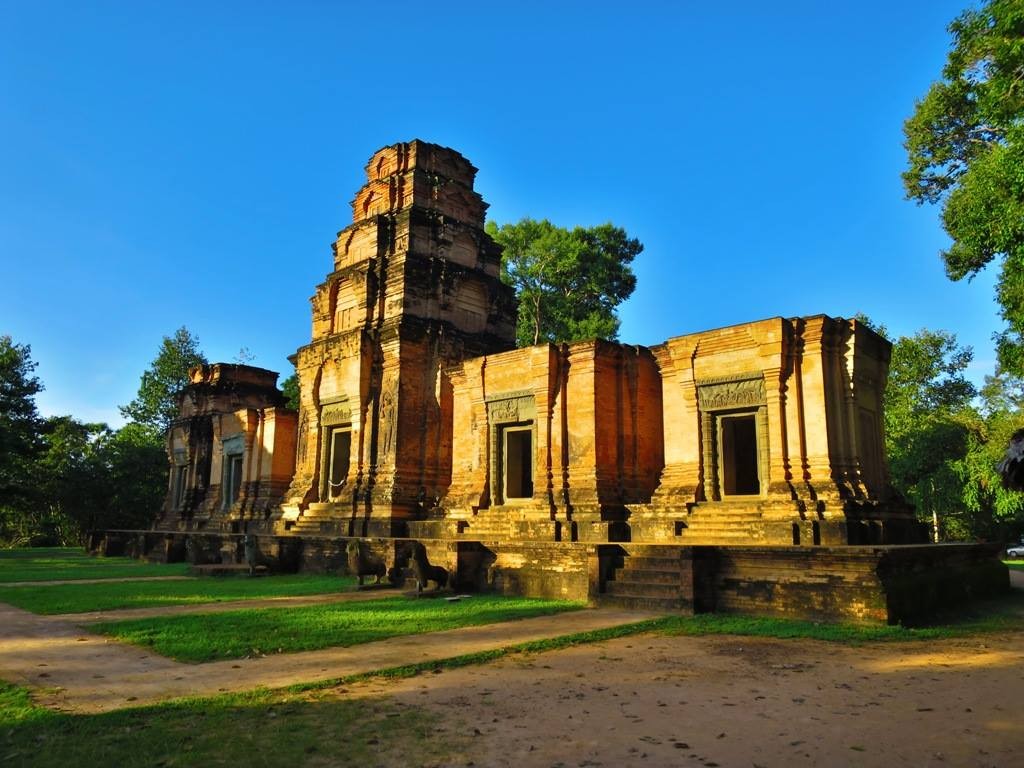
I was annoyed that the driver missed this on the petit circuit the day before, and I only learnt about it from the other group who went out with us. The small site is surrounded by a moat and the bas-reliefs have been chiselled into the brickwork. No, not stone or stucco, but bricks. Like the person who took this photo, there was hardly anyone around.
Banteay Kdei & Sra Srang
Tourists on the small loop are dropped at the western end and picked up on the other side if they even visit it at all after a long day. The entrances at both ends bear the serene faces that also feature on the Bayon, and like Ta Prohm, large parts lie in piles of overgrown rubble. Having already been there, though, we stopped for a different reason.
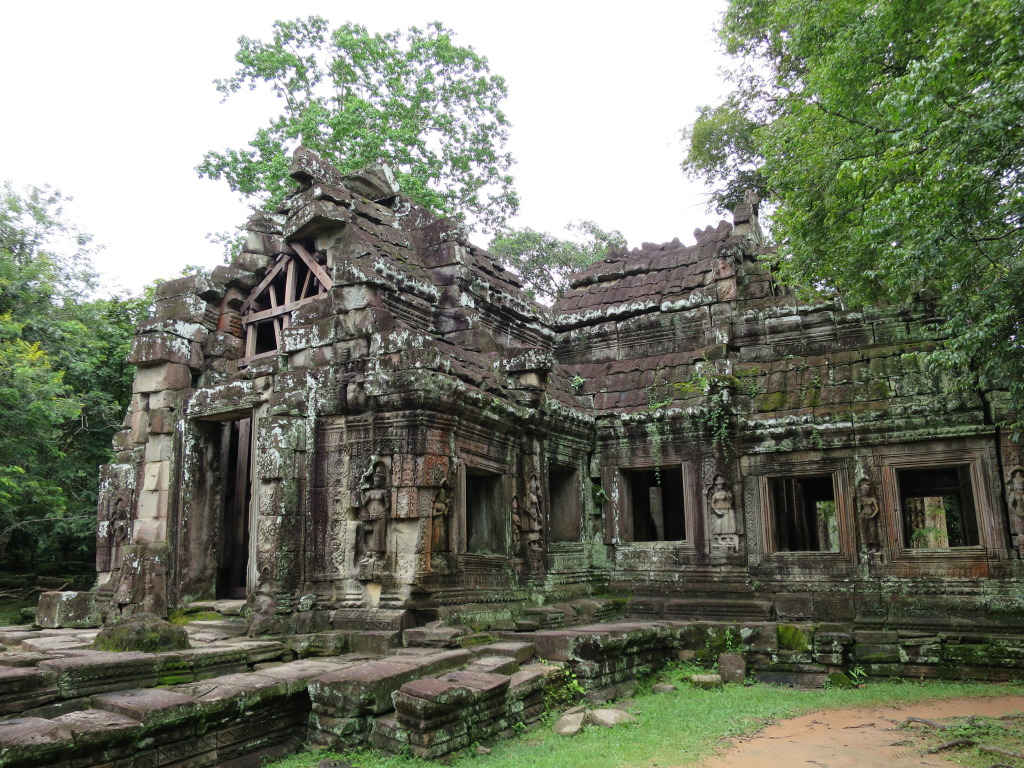
Across the road, the man-made reservoir Sra Srang is a picturesque spot when boatmen from the village take to the water under a blue sky. It’s easy to forget that Cambodians live in this park until one wonders where the touts sleep after a day of pestering visitors.
After waving off the drinks stallholders, we were enjoying the scenery when a voice interrupted us from below.
‘Where do you come from?’
My companion made the mistake of mentioning a well-known developed country, and the waif proceeded to rattle off every fact she’d memorised. Okay, very good, but that won’t make us buy anything. How nice it must be that they had access to books on geography or, in all probability, Wikipedia.
Pre Rup
We approached Pre Rup from the south-west and the temple mountain was very impressive. It’s all red sandstone and keeling towers, and the levels rise steeply from the ground. No one was at the south entrance and it looked a bit dodgy, but we rounded the bend and lo, a proper entrance was there with park officials, drivers, touts and all.
Steep steps aside, the climb to the top tier wasn’t as hard as it appeared. From there, the forest extended as far as the eye could see and Angkor Wat was just a speck I couldn’t make out at all. We still had heaps of fun, as much as one can when busloads of clueless tourists aren’t getting in the way. While the stone lions and reliefs had weathered badly, the elephant sculptures were still in great shape.
Carry on cycling north and you will pass a T-junction. If you want to stay on the Grand Circuit, keep going straight. The road on the right leads to Highway 67; turn left at Preah Dak and it will take you to Banteay Srei.
East Mebon
The East Mebon used to be a temple island in the middle of the former East Baray, a massive reservoir which once extended to Pre Rup to the south. It’s now covered with grass, tarmac and cow pats, depending on where one looks. It does not rise as high over the enclosure walls as Pre Rup, so it does not reflect well in the puddles outside.
As far as we were concerned, the highlight was the herd of water buffalo that passed the entrance. After two days of dealing with touts, I was surprised that the chap who was tending to them did not attempt to charge me for my photographs.
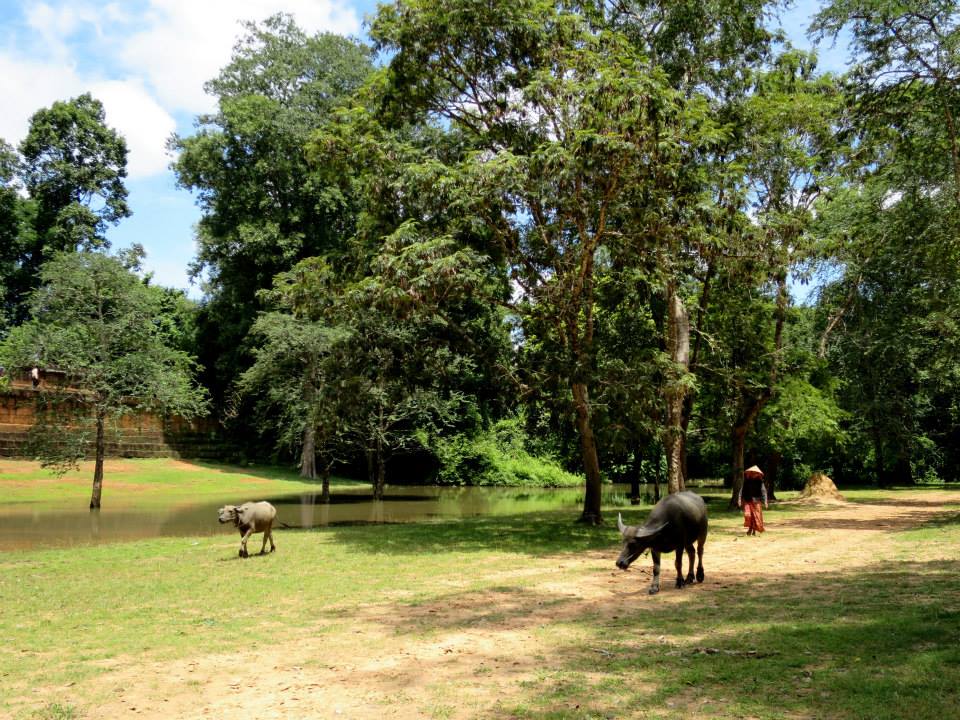
Paddy fields
We noticed that a tuk-tuk had pulled over in the middle of nowhere. The German occupants were looking at something in the distance, so we stopped next to them and did likewise. Through a gap in the foliage, we watched a group of rice farmers working on their nursery like the voyeurs that we were. I certainly felt guilty but like the other visitors next to me, it was I sight that I don’t get to see back home.

Ta Som
It feels like Banteay Kdei in some ways – the flat terrain, heaps of rubble a stone’s throw from some well-preserved bas-reliefs and the boddhisatva faces watch over the entrances. In addition to that, chickens roam the ground, and there was something worth going to the end of the complex for.
We kept walking straight in, and right at the end, the strangler fig had grown over and around the eastern portal. From the inside, it appeared as if the tree grew right out of the head of the deity that it sheltered.
And on the other side, the touts and their kids were also waiting for us.
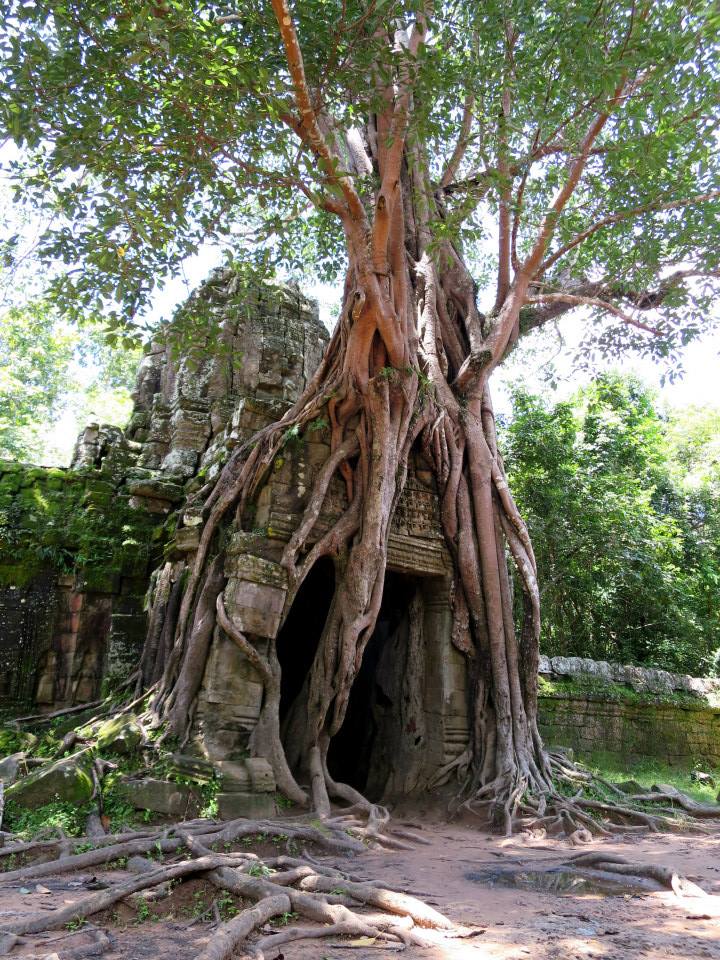
Neak Pean
We arrived just as an English couple who were cycling in the opposite direction were being gouged. The lass had a leaky tyre and the locals wanted $5 for their help. $5 for air, imagine that. Unfortunately, without a pump, we couldn’t help them out either, and the problem was bound to recur further down the road.
I was excited to reach Neak Pean as I wrote a term paper about the place. From a tourist’s point of view, it’s refreshingly different from all the temple mountains and cloisters in Angkor that we’d explored. The shrine rises from the middle of a pond on the backs of coiled serpents like a mini temple-mountain. Four pools surround and feed this pond. An overgrown moat forms the outermost edge of this island, and the only access to it is via a narrow causeway in the middle of a vast reservoir. It’s all symbolic but that’s still a lot of water barriers.
It was a minor disappointment to be unable to walk around the site. The beggars and touts that lined the causeway did not help when space was at a premium. At least we got to know our new English friends a little better and take their minds off their misfortune.
Nearby: Krol Ko, Banteay Prei, Prasat Prei
There are tout-free minor ruins in the undergrowth that lines the road. They can be hard to spot as the paths that lead there are usually overgrown. We did not explore them either but I’ll give them a mention for those who are determined. Krol Ko is right opposite Neak Pean; Banteay Prei and Prasat Prei are close to the toilets opposite the Preah Khan turn-off.
Preah Khan
This site was immense, considering it’s a “small ruin” compared to Angkor Wat. Maybe fatigue had something to do with it; by this time I was out of water, crisps and biltong. I needed a sugar rush – but which tout do I go to, when they all sell the same things? I offered payment for the first cold can of Fanta orange that was brought to me. Ideally, I should have settled this via a battle royal. That would’ve been the best solution for every visitor.
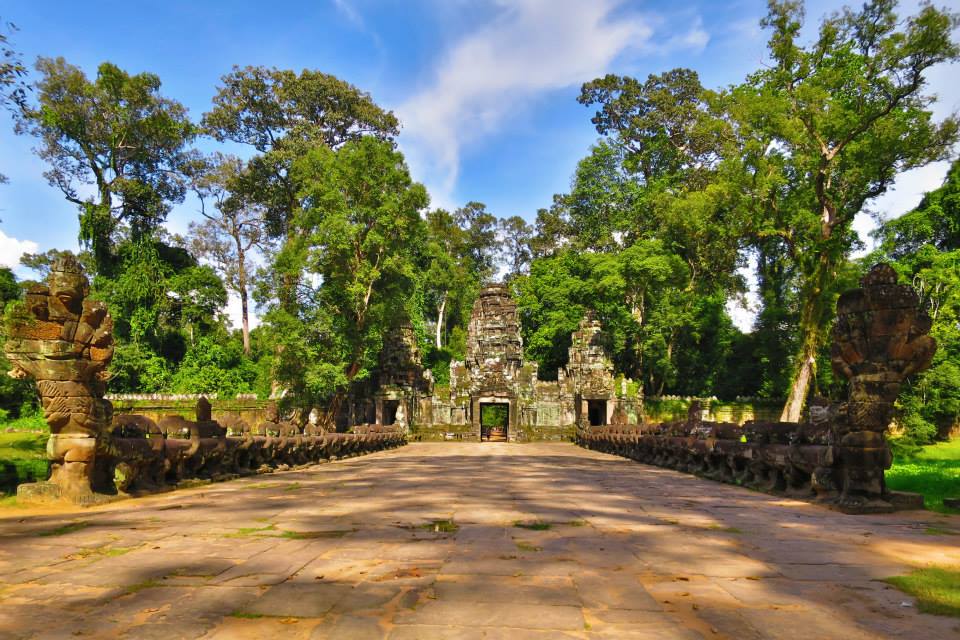
As with Banteay Kdei, tuk-tuks drop visitors off at one end and pick them up at the other. That was obviously out of the question for us. From the eastern side, which we visited first, the site seemed off limits due to the restoration works on the gateway. However, one door was left open.
It was the little things I could recognise that made me smile here. Garudas reared their forelimbs all along the perimeter wall, while headless deities and demons pulled on the serpents lining the bridges. Linga and Buddhist idols shared the same inner sanctuaries. This mishmash of religious symbols is not uncommon throughout Angkor.
The North Gate
It’s not terribly different from the other four magnificent face-tower gates, but the chances of getting run over here while taking a photograph are lower than at the South Gate, which is part of the petit circuit. The recently restored sculptures on the bridge were an eyesore, though – too smooth, too concrete-like and too sterile. It’ll be a long time before they look anything like the original stone, even if they manage to stay in one place. Damn those thieves and vandals.
I felt bad about leaving Ari alone with the three young kid-sized touts as I took photographs. By that time, I’d said no more times than KT Tunstall in Black Horse and the Cherry Tree‘. My home country had also become Magrathea. When I returned, she was counting to thirty with them. R.E.S.P.E.C.T.
Bayon
When we visited the Bayon the previous morning, the grey skies and the wet masonry made for some dull pictures. We rejoined Tourist Central and climbed the temple mountain of 216 faces. The late afternoon light was gorgeous. 24 hours ago, we had to move on to Baphuon and the Elephant Terraces in the rain; now we had the luxury of cycling around the ruin to photograph the reflections in the puddles.
These moments were gold for my companion – she ran into friends she made at the border crossing and saw families of macaques up close as we headed south.
Phnom Bakheng
This massive but crumbling pyramid is even more impressive than Pre Rup to behold. However, our experience was far from stellar. For most of the visitors, the ruin was just a platform for watching the sunset over the West Baray. From 3.30pm they climb en masse up the knoll to the base of the temple, where there is a queue to get to the top.
There were iPad-wielding tourists everywhere we looked. It was impossible to explore the details of structure because careless halfwits had rubbed them out over the years by leaning or sitting on them. What was left was obstructed by the crowds milling around. The view of Angkor Wat was great, but that’s the only good thing that I can say about it. It needs to be shut down for a thorough restoration.
We decided not to be hypocrites and left well before sunset. The view from one of the lookout points on the way down was just as spectacular. It also came without the risk of a stampede.
P.S. On another day try catching the sunset in Phnom Krom instead.
The stall across the road that sold grilled skewers was doing a brisk trade with the locals. The staff didn’t even try to get our attention, so that was where we had our first proper meal since breakfast. Each of us bought four well-marinated sticks and a pickled salad. I would’ve gladly paid more than a dollar for them.
Returning to Siem Reap
With the light fading quickly, we had no intention of riding to the hostel in darkness and heavy traffic. There were plenty of drivers which didn’t already have passengers on Phnom Bakheng (I wasn’t expecting this). Ari managed to find a tuk-tuk driver who was willing to drive us and our bikes back for $7. It was a tight fit but it worked.
‘If you hadn’t come along, I think I would have turned around and gone back after the first temple,’ she mused as we reflected on the day’s events. How did we manage to cover this much ground on the equipment we had? I had not given it a thought and it was only beginning to sink in.
30 kilometres, 30-degree heat, pedal power and no gears – it was fun, but once is enough!
Have you cycled around Angkor’s ruins or visited the lesser-known sites? Which was your favourite?


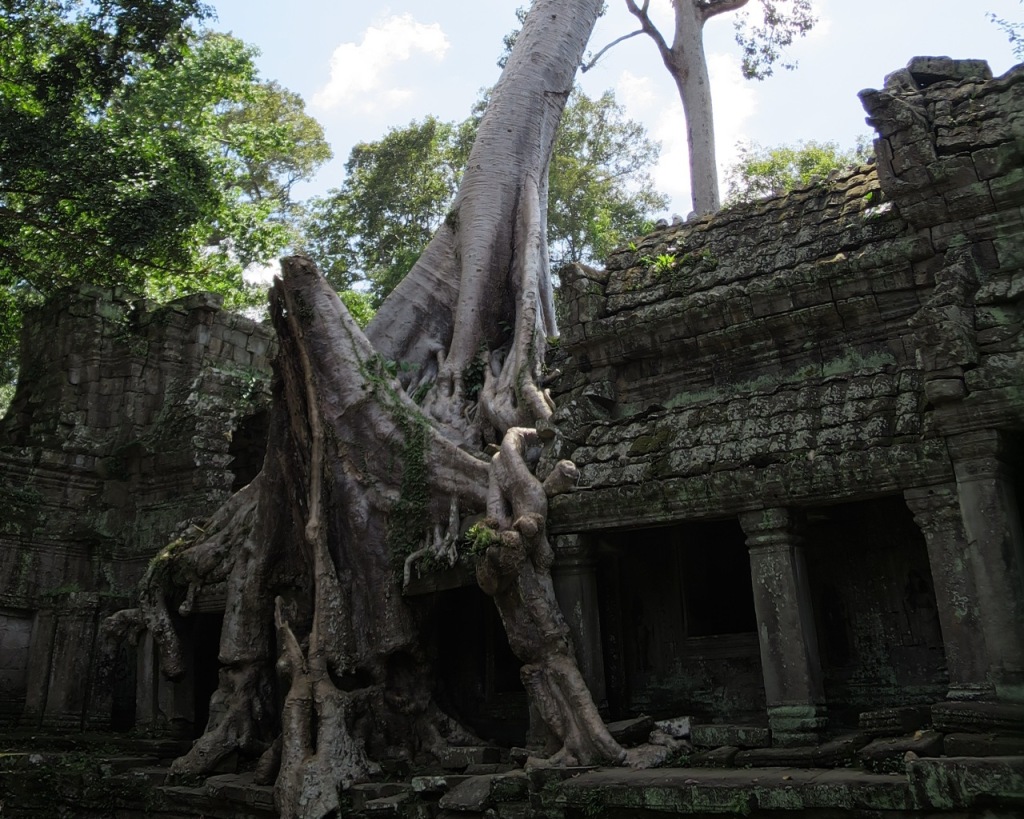

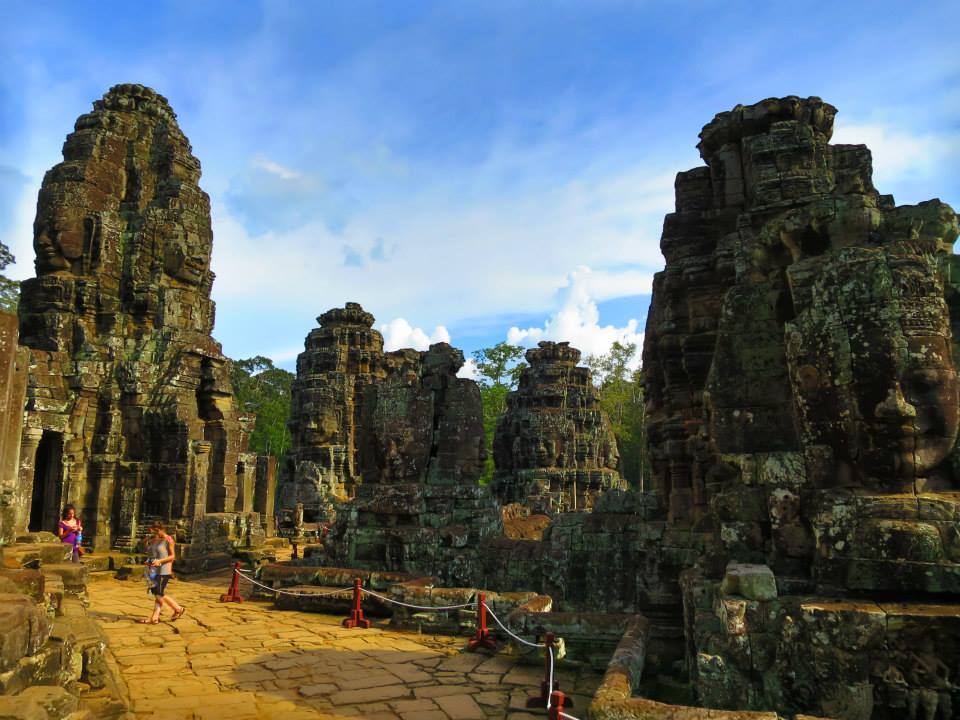
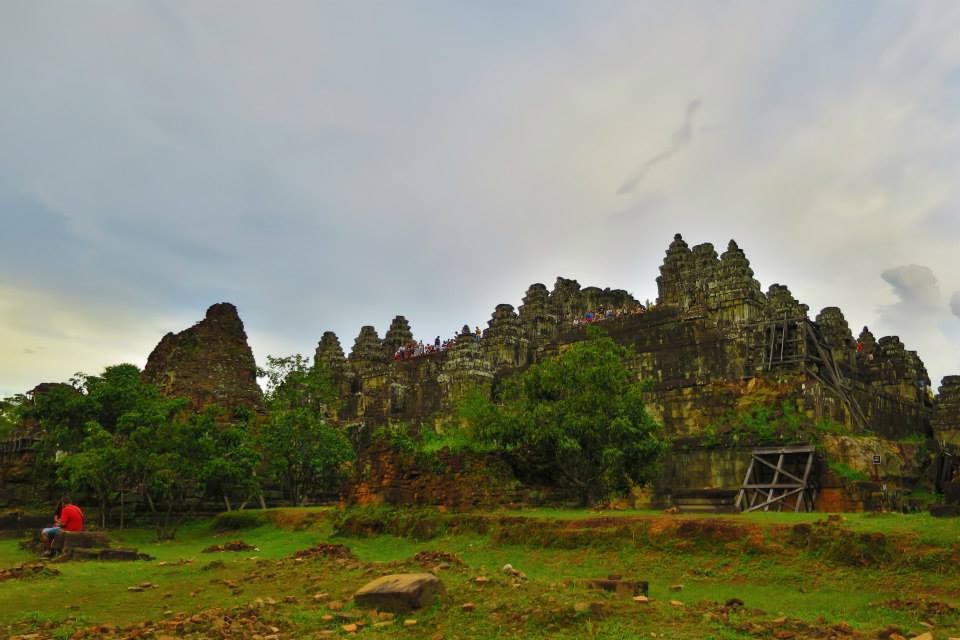

09/12/2014 @ 10:35 AM
Hello Nicholas! Great post about Siem Reap. I love my Siem Reap adventure too, but I haven’t been to some of the places you’ve been to. My favourite is probably Bayon Temple (next to Angkor Wat).
It was a wonderful experience — like being back in time. If only there were less vendors and beggars…
When I go back, I will try cycling too :)
10/12/2014 @ 1:46 PM
Thanks, Cat! The whole park definitely feels like another world if the people are left out. It’s a gruelling ride, especially with an old bike, but give it a go!